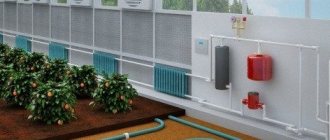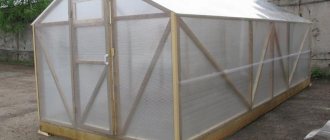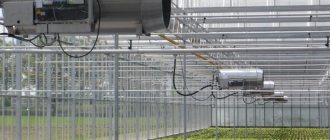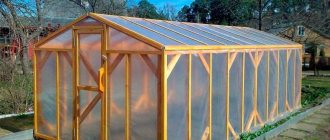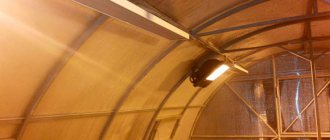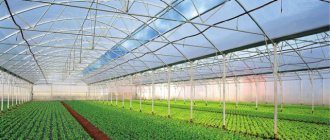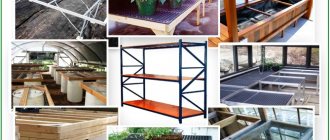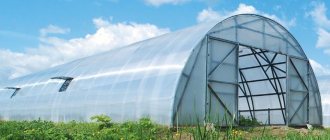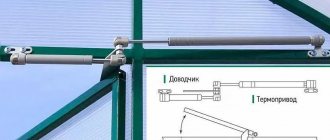Equipping a greenhouse with an infrared heating system
An infrared heating system for a greenhouse can be suspended, recessed or mixed, depending on the needs of the vegetable grower. So:
- If the shelter is used only during the season and is intended for growing heat-loving crops, upper radiation is sufficient;
- If you are engaged in early cultivation of seedlings and greens (see Greens in a greenhouse), it will be more effective to use equipment laid deep in the soil to warm the soil after winter frosts;
- For year-round vegetable growing or floriculture, it is advisable to invest in comprehensive heating.
How is this done in practice?
Heating from above
The simplest and most affordable way is to mount the heaters on the walls of the greenhouse or hang them from the ceiling, connecting them to an energy source and directing them to the beds
Since the weight of thermal plates does not exceed 3-5 kg, there is no limit on their number, it is only important to correctly calculate the required power, taking into account the shape and area of the greenhouse. An infrared heating system in greenhouses can use heaters or lamps as a radiation source: The heaters are infrared ceramic emitters enclosed in a protective casing.
For effective distribution of beams, the casing is equipped with a reflector, and for ease of connection, it is equipped with a mounting block with a cable. Installation instructions are included with each device, so installation will not cause you any difficulties.
The heaters are infrared ceramic emitters enclosed in a protective casing. For effective distribution of beams, the casing is equipped with a reflector, and for ease of connection, it is equipped with a mounting block with a cable. Installation instructions are included with each device, so installation will not cause you any difficulties.
IR heater
As a rule, it is carried out at a distance of one and a half to three meters from each other, this distance depends on the dimensions and power of the heaters, their height above the planting level and the temperature in the greenhouse. You can learn more about the installation of radiating equipment by watching the video offered in this article.
IR lamp
Both lamps and heaters are resistant to mechanical stress, temperature changes, the influence of chemical reagents and high air humidity. The installed infrared heating system for a greenhouse is located at a height of at least a meter from the plants, but this distance is more accurately determined taking into account the heating area and the required temperature required for growing greenhouse crops. Moreover, the higher the heater is, the larger the area it will cover, but the less heat the soil will receive.
Heating from below
To directly heat the soil from below, infrared systems are used for heating greenhouses in the form of special films laid in the ground. Installation is carried out according to one of the selected schemes:
Horizontal. In this case, the film is placed under the beds to a depth of at least 50 cm from the surface.
Bottom heating device using IR film
Vertical. The film heater is installed vertically in the ground between the beds and along the perimeter of the greenhouse.
Bottom heating is more difficult to install, but more economical, since radiant energy directly heats the soil and air at the lower level of the shelter, which reduces energy consumption.
Diagram of connecting the film to the network and thermostat
This method also has some disadvantages
For example, when replacing soil in a greenhouse, which many vegetable growers carry out annually to prevent plant diseases, care must be taken not to damage the system
The essence and advantages of the method
Traditionally, wood and gas stoves, convector heaters, and water heating are used for heating greenhouses and greenhouses. All these methods require large material and physical costs for installation and maintenance.
Features of infrared heating
The infrared heating system for greenhouses differs from the traditional methods listed above in that it does not heat the air, but all objects located in the radiation field - the ground, plants, walls, etc. This radiation is similar to solar energy: heated earth and other objects emit infrared photons, which are reflected back by the walls of the greenhouse. All other methods are aimed specifically at heating the air, the warm vapors of which rise upward, practically without warming the soil and leaving the plants cool.
The fundamental difference between convective and infrared heating is clearly visible in the diagram
Infrared heating systems for greenhouses are distinguished by the fact that their radiation is directed from top to bottom and affects plants and soil, which is important for rapid germination, development and fruiting. Numerous studies have proven that, thanks to them, seed germination increases by 30-40% precisely due to warming up the soil, in which the air does not heat up so much. In addition, infrared heating for greenhouses can also be laid under a layer of soil - special films are designed for this
Advantages of the method
The main advantage of an infrared heating system for greenhouses is its high efficiency, reaching 95%. This impressive result is explained by the fact that all the radiated heat is spent on heating the soil and plants, and not the air surrounding them. It, in turn, warms up due to the reflected energy. Other advantages are no less significant. These are:
Significant reduction in heating costs both due to directed radiation and due to the small amount of electricity consumed.
- There is no need for additional air humidification, since these heaters do not dry the air.
- The operation of the system is similar to solar radiation and therefore is completely safe for both plants and people working in the greenhouse.
- The heaters do not make noise and do not glow, so they do not create any discomfort.
- Fast heating: you can raise the air temperature in the shelter to the specified parameters in a matter of minutes.
- The ability to create several zones with different temperature conditions in one greenhouse. Depending on the needs of a particular crop, you can change the power and height of the heaters above them, thereby creating the optimal temperature in the growing area.
The photo shows that the radiation extends only to the area under the heaters
- Simplicity of installation and dismantling - heaters are easy to install with your own hands or with the help of one electrician, which also allows you to save money compared to installing heating systems.
- The presence of a thermostat (see Thermostat for a greenhouse) is a very important option for growing plants that require different regimes at different stages of the growing season.
- Fire safety due to the absence of open flames and heating elements.
- Mounting on walls or ceilings frees up valuable greenhouse floor space.
Saving space is especially important for small greenhouses
Operating principle of IR heater
Infrared heaters differ in operating principle from other devices; they heat not the air, but the surrounding objects, that is, they act on the principle of sunlight.
Diagram of heat distribution in a greenhouse.
When taking pictures of the situation in a room with thermal cameras using infrared devices, you can observe the following picture: the maximum temperature is observed near the equipment and near the floor surface, that is, heating is felt immediately after switching on. But with a conventional heater, warm air rises to the top, that is, you have to wait a very long time for the temperature below to rise, and this significantly increases energy consumption. That is, we can conclude that infrared heaters are much more economical; it is recommended to choose them when electricity consumption is critical and comfort is a priority.
Lamp and film heaters with minimal energy consumption
To install an effective and simple IR heater, ceiling lamp and film structures are often used, which are very easy to install and their energy consumption is quite economical.
Diagram of a lamp IR heater for greenhouses.
Lamp infrared devices use halogen lamps with a tungsten filament in a flask filled with a mixture of argon and nitrogen as a radiation source. The power of such lamps is 150-250 W, which is quite enough to heat an ordinary living space. Lamps for such devices are produced in different ways:
- conventional infrared mirrors, which are similar to conventional lighting lamps, but emit a larger amount of IR rays;
- mirror red infrared lamps with a bulb made of dark red glass, they give little light, but more heat, and energy consumption is much less.
Film infrared heaters are attractive because they do not have a housing, that is, they are a film with carbon paste one micron thick. This film has copper contacts. You can choose such a heater if you need to heat the device to a maximum of 110 degrees, and the average heating temperature is 30-45 degrees Celsius. The energy consumption of a film heater is not very high; it is often used for installation not only on ceilings, but also for floor heating.
Gas panels and long wave IR
Gas IR heaters are mainly used for local heating of small outdoor areas. This allows you to create comfortable conditions on verandas, outdoor cafes, and terraces. Often gas appliances are designed in the form of elegant modern lanterns that serve as design decoration.
Types of IR radiation.
The device itself consists of gas cylinders hidden under the base of the umbrella. The consumption of the cylinder is very economical, it lasts for 22-25 hours of continuous operation, so they are often taken on picnics, placed on playgrounds, sports grounds, and parks. There is enough power to feel comfortable even at sub-zero temperatures.
Gas ceiling heaters are used when a mobile heat source is needed on an area from 9 to 60 sq.m. The fuel is bottled liquefied gas.
Most often, long-wave devices are used to heat a house, the radiation source of which is a special aluminum alloy plate with a special coating. Such a plate is heated by heating element up to 300 degrees Celsius, between it and the body there is a heat-insulating material that ensures heating of the body itself to only 50 degrees, that is, the heat is directed exactly where it is needed.
Household IR devices of this type are produced in the form of rectangular cases; they are mounted on the ceiling with special brackets; the angle of inclination of the device can be easily adjusted. Long-wave devices are very convenient for heating not only in residential premises, they can also be successfully used for offices, shops, and kindergartens.
Operating principle
Let's consider how to properly organize heating of a greenhouse with an infrared heater, which, according to its operating principle, resembles a natural process and is most suitable for growing plants.
Like solar energy, infrared emitters heat surfaces and objects on them. Due to the accumulation of heat by objects, the ambient temperature in the room also increases. The process is natural, gradual, the necessary energy is supplied evenly, which has a beneficial effect on the growth and development of plants. The following is used as fuel for infrared heaters:
Also, devices can be light or long-wave. Available in the form of special lamps or panels.
For greenhouses located in summer cottages, long-wave heaters are better suited; light heaters have too much power and are used in large industries.
The selection criteria depend on you ↑
Traditions of our grandmothers
By and large, this is actually true - everything (or almost everything) depends on your own requirements and conditions. So, in early spring, on days when the seedlings in greenhouses are slightly frozen, some gardeners like to use large candles placed between the rows and beds of seedlings. And this is really quite enough for small greenhouses, where they grow dozens, or even hundreds of bushes.
To equalize temperature at night, heated bricks and hot water in containers are sometimes used. Several bricks and a bucket of water are placed in the greenhouse at dusk and left until morning. By giving off their heat, these objects prevent the night temperature from falling to critical levels. Such traditional methods are still quite applicable today. Although more efficient farms strive to acquire modern equipment that provides more significant advantages.
Fan heaters
They were appreciated due to the convenience of quickly pumping warm air into the space. But their disadvantage, which consists in excessive drying of the air and uneven distribution of heat, cannot be ignored.
Gas appliances
Many consider them to be one of the worst options for greenhouse heaters. They are based on a gas pipeline and a regulatory system. The air is heated using a heat generator, and, being already at altitude, is supplied to the greenhouse. The big disadvantage of this system that has not yet been overcome is the excessive dryness inside the greenhouses, which is detrimental to plants.
Oil heaters
These are considered not at all rational for these purposes. They spend too much energy that it does not pay off in the resulting harvest. In addition, they take up useful space, because it is not recommended to plant plants next to them either. And experts also call drops of condensation possible in greenhouses a risk factor for oil heaters.
Useful tips
For small drops in temperature and short-term frosts, which can be observed at night in the off-season, you can use the following techniques and primitive homemade heating devices:
- You can make a primitive heater from a candle. Place a candle placed in a tin can of stewed meat in an iron bucket with holes on the sides, pour sunflower oil into it and cover with a lid. The candle should be well strengthened - placed on a self-tapping screw. This candle will burn for a long time.
- Place buckets of coal around the greenhouse and place bricks under them.
- Another option is from a kerosene lamp and a bucket. Place two bricks on the sides of a lit kerosene lamp and place an iron bucket on them.
To heat protected soil, savvy gardeners sometimes organize joint heating of a bathhouse and a greenhouse. A greenhouse structure attached to your home will also help reduce heating costs. From such a glazed structure you can make a greenhouse or winter garden. Only such buildings should be planned before building a bathhouse or installing heating systems.
Did you know? The usual heating system for buildings, which we still use today, was invented by the English engineer Evelyn back in 1675. He used it to heat the greenhouse.
Heating the greenhouse will allow you to obtain larger yields, extend the warm period for the crops grown, and also protect against freezing in the off-season. Now there are many varieties of heaters and heating systems for greenhouses. In addition, you can make a heating device yourself.
Advantages inherent in infrared heaters
- uniform distribution of heat in the required area of the greenhouse;
- help get rid of drafts;
- opportunity to save energy;
- have a beneficial effect on plant growth;
- the growth of pathogenic bacteria and viruses is suppressed;
- high practicality.
Diagram of a ceiling infrared heater.
Let us dwell in more detail on each of the advantages.
Unlike convective heating systems, from which warm air tends upward and cold air accumulates at the bottom of the greenhouse, heat distribution with infrared heaters occurs differently. Uneven temperature distribution is excluded with them. Plants are sufficiently provided with the necessary heat due to the fact that heat loss is minimal.
Many representatives of the flora are too sensitive to drafts; infrared heaters help cope with this problem. For these purposes, the device is placed in an area where thermal insulation is reduced (for example, near windows). Without forming air flows, it compensates for heat losses.
The practicality of the IR heater lies in the fact that it can be used to create thermal zones with different characteristics for growing vegetable crops with different growing conditions under one roof. This directly relates to efficiency, since greenhouses are not heated completely, but only a certain part of them. Correct installation and operation of devices can reduce energy consumption by up to 40%
They work without creating noise, which is important for both plants and humans. IR heaters are compact, mobile, and do not take up much usable space (floor and walls), which is highly valued in a greenhouse
They are easy to install and remove from the ceiling space. The height of suspended infrared equipment will depend on the temperature to which the soil needs to be heated. When growing seedlings, the IR equipment descends lower to the plants, and as they grow, it rises. They do not dry the air, which is important for greenhouse conditions.
What is this device capable of? According to experienced gardeners, seed germination increases significantly (by about a third). This is due to the fact that IR heaters, warming the soil by 5-7 centimeters, stimulate the root system of plants, creating all the necessary conditions for root growth. Other heating devices cannot provide a similar effect of targeted soil heating. Infrared radiation can heat the soil to a temperature of +28 degrees, which is optimal for plants. And the air heating remains at +21°.
general information
When growing garden crops in a greenhouse, it is necessary to pay special attention to the microclimate. Regardless of the time of year and ambient temperature, comfortable conditions must be present inside the building under which the growth, development and productivity of plants will be most productive
And no matter what type of heaters will be used, it must perform its basic functions in the best possible way.
Infrared heaters imitate sunlight
Some gardeners set up heating systems with their own hands, building small solid fuel stoves. However, such inventions are not known for their safety and require constant monitoring and addition of fuel. In addition, they heat only the air, which is why the efficiency indicators are seriously reduced. Often, pipes with water are supplied to the structures, which are located around the perimeter of the greenhouse. Unfortunately, this approach does not improve heating productivity, but only requires large investments.
The next type is electric air heaters. They are easy to install and also support full automation, which makes them comfortable to use. Unlike the previous type, such systems do not heat the air, but they also do not boast a high level of efficiency.
Among the advantages of electric-powered fan heaters for greenhouses are instant heating of the interior space, although this leads to one unpleasant phenomenon - excessive drying of the air. In turn, dry air negatively affects green spaces and reduces yields.
The most unsuitable heater option is a gas appliance. When operating such a system, any air humidity drops to minimum levels, which entails disastrous consequences for the crops grown.
Also, when arranging electric heaters for greenhouses, soil heating cables are considered. They are capable of warming up the root system of plants, but are expensive and require expensive maintenance.
In this video you will learn more about infrared heaters;
Kinds
IR heaters are extremely popular despite their rather high cost. There are many models of different power, for different areas, on different fuels, and so on.
According to the installation method, devices are divided into 2 types^
- Stationary - the presence of a heater in this case is provided for at the construction stage. This solution is rational in the case when the greenhouse needs constant heating and has an area of at least 15–20 square meters. m. Otherwise, a mobile model is quite sufficient.
Installed on a permanent basis, often without changing position
- Portable - designed for heating a small area - up to 15 square meters. m. The heater can be moved from place to place or mounted on suitable surfaces.
Most often used in small rooms
By food type
- Electrical - thermal radiation is generated by a special element. For this to happen, it must be warmed up. In electric heaters this occurs due to electric current. Based on the type of heating element, the following types are distinguished:
- ceramic – the heating element is a ceramic panel. Its large area guarantees heating of a large area of the greenhouse. Ceramics are practically eternal and do not react to temperature changes. Another interesting property is that the ceramic element does not glow in the dark. The disadvantage of the device is that it takes a rather long time to warm up - up to 15 minutes;
Ceramic infrared heater for greenhouses
- halogen – the heat source is tubular quartz heaters. This option heats up much faster, but is designed for a smaller area. Performed in any version - floor, wall, ceiling;
Installed in not very large greenhouses
- carbon - heat is generated by a quartz tube, inside of which there is carbon fiber. This model is very durable and effective: almost all models are equipped with reflectors. On average, a 500 W model warms up an area of 10–12 square meters. m;
Installed in pairs or in combination of 3-4 devices for the best effect
- Gas - gas is used to heat the element, which emits infrared radiation. There are 2 types of devices:
micathermic - ceramic tubes serve as the heating element. This is the safest option among all electric heaters. This structure is best suited for wall and ceiling units.
Efficient, long-lasting gas appliance
But in order for the heat to reach the beds in full, it is worth understanding how to make beds in a polycarbonate greenhouse.
Film - or tape. The heating elements are fixed to foil, which acts as a reflector and is covered on both sides with a laminated film. The thickness of the tape is only 1.5 mm. In rooms, a film heater is usually installed on the floor, but there are ceiling models. They are ideal for greenhouses. The film heater creates uniform heating, does not dry out the air, does not require maintenance and is easy to install.
This is what a strip infrared heater for greenhouses looks like
Devices are also classified by type of radiation:
- light – heat up to 600 C. Models are used for greenhouses with a large area;
- long-wave - they heat up to above 300 C. This power is enough for heating small greenhouses.
Also, don’t forget about how to install it yourself and use it correctly to ventilate a greenhouse.
This parameter distinguishes between:
- models with a thermostat - the device allows you to set and maintain the radiation power, which, in turn, provides heating or temperature maintenance. However, they do not estimate air temperature or humidity;
Installed permanently
- options with a thermostat - provides for turning off the heating when a certain temperature or humidity is reached. The thermostat can maintain the temperature according to the set schedule.
You can also organize the cultivation of watermelons in a greenhouse, but how to do this correctly is described in detail here.
Peculiarities
When organizing heating, you need to pay attention to a number of important points:
- It is better to arrange devices in a checkerboard pattern, this way you can eliminate uncovered areas;
- Devices with a power of 500 W should be installed along the walls or in this direction; it is in these places that the temperature is lowest. 250 W devices can be placed directly above the plants;
- The distance from the heater to the seedlings should not be less than one meter; as they grow, the device should be raised;
- In the absence of good thermal insulation, you can make a warm floor. A special infrared film for a greenhouse is laid horizontally, directly under the ground, and provides the necessary heating of the room. But in this case, you should take care of waterproofing;
- Infrared film can also be used vertically, placing it around the perimeter of the greenhouse, but this method is less economical than horizontal;
- Greenhouses made of polycarbonate retain heat longer than structures using film or glass;
- To correctly calculate the required total power of heaters for a specific greenhouse, you should multiply the coverage area and the difference in temperatures inside and outside the room, and multiply the resulting product by the thermal conductivity coefficient of the material with which this greenhouse is covered.
Interesting: for heating a glass greenhouse three by six meters, the following calculations can be made: 18 sq.m. * (20 degrees inside - 0 degrees outside) * 8.6 W (coefficient for glass) = 3,096 W. This means that you need to purchase at least three powerful 1,000 W devices.
- For year-round growing of plants, it is better to use a comprehensive solution, combining underground and suspended systems, and in severe frosts, additionally use portable devices.
- When using electrical equipment, you should take care of uninterruptible power supply systems or heaters that run on other types of fuel.
Fresh vegetables are available all year round to any summer resident who has a heated greenhouse. Currently, this is easy to achieve using modern equipment. Infrared film for heating greenhouses, suspended or portable systems are presented in a large assortment, everyone can choose the option of the appropriate size with the required power. The experience of gardeners proves that infrared heating is the most economical, durable and effective way to heat greenhouses, closest to the natural process.
Heating a greenhouse can significantly increase the growing season of plants. In practice, many methods have been implemented, the choice of which depends not only on the type and area of the greenhouse, but also on financial capabilities. As a rule, buildings whose operation is on a commercial basis are connected to heating. Consequently, the closest attention is paid to saving issues.
This article will provide an overview of the most common methods for heating a greenhouse in winter. Their advantages, disadvantages and a brief comparison of the main technical, economic and operational characteristics.
Type ECL-I 500 W
A special feature of the infrared heater type ECL-I 500W is its manufacturing basis. It is produced on the basis of ECS ceramic emitters having a spherical surface. This design makes it possible to remove the emitter from the heating surface.
The main technical parameters of the heater are:
- power – 500 W;
- voltage – 220 V;
- dimensions – 280x210 mm.
Methods for placing a heater type ECL-I 500 W
Heaters must be located in the greenhouse at a height of no closer than 1 meter to the ground surface. When the plant converges and grows rapidly, the heater should be gradually raised. A heater of type ECL-I 500 W is installed on a rigid base. This makes it possible to adjust the height of the suspension.
Based on the power of this heater, it is important to install it not in the center, but closer to the walls of the greenhouse. This will help maintain the room temperature
Quantity
Depending on the area of the room, heaters are installed in the amount of 1 piece every 1.5 meters. The higher the emitter is suspended, the larger the surface area it emits. But this also leads to the fact that distant plants receive less heat rays. It is an excellent solution for small greenhouses, and for larger ones 2-3 heaters are used.
The price of this type of heater is in the range of 900-1100 rubles.
Kinds
When choosing an IR heater, one takes into account several criteria.
Existing types of “infrared” can be:
- electrical;
- gas (halogen);
- diesel.
Heating element type
Electric heaters are equipped with the following types of heating elements.
- Ceramic - they have increased strength, heating for them is a matter of minutes, they cool down just as quickly;
- Heating elements - the advantages of tubular electric heaters are reliability and stable maintenance of the set temperature;
- Carbon - the design of such a heater is represented by vacuum tubes with carbon-hydrogen fibrous filler.
Form
In appearance, heaters can be infrared lamps of various formats, film panels or tapes. Compared to lamps, film or tapes provide the greatest energy savings and heat the soil more evenly.
Installation method
Before purchasing a “personal sun”, you should immediately decide on the placement of the device.
Depending on the mounting method, the equipment can be:
- mobile;
- stationary.
There are no questions regarding the first one - this is a portable equipment that can be moved to the desired location using wheels or special legs.
You can experiment with the installation of stationary models as much as you like, since they are available in several types:
- ceiling;
- wall;
- baseboard;
- hanging.
Suspended models differ from ceiling ones in the principle of fastening. Suspension-type heaters are built into a suspended ceiling structure, which is pre-designed for the placement of devices. To fix hanging devices, use special brackets and anchor bolts in increments of 5 to 7 cm.
Heating temperature
IR equipment differs in the degree of heating of the device itself.
Devices can be:
- low temperature – up to 600°C;
- medium temperature – from 600 to 1000°C;
- high temperature – more than 1000°C.
Emission range
In accordance with this parameter, IR equipment is:
- long wave;
- medium wave;
- shortwave.
According to Wien's law, there is a direct relationship between the wavelength and the temperature of the surface on which the radiation hits. Under high-temperature radiation, the wavelength increases, but at the same time they become hard and become dangerous.
IR heaters have additional options.
- Many models of infrared equipment have a thermostat (temperature regulator) that is responsible for maintaining the set temperature.
- Any thermal heater must be equipped with a thermal switch that reacts to overloads and automatically turns off the device, preventing it from overheating.
- To ensure comprehensive safety, IR equipment is also equipped with insulators that prevent contact of the housing with the heating element.
- Particularly advanced models have a light indication that informs the user about a problem that has arisen so that he can quickly navigate and take measures to eliminate it.
- Spontaneous shutdown of floor-standing models occurs when tipped over, which simultaneously prevents damage and reduces the risk of fire to zero.
- The presence of the Antifrost system is designed to protect the heating device from the formation of ice. Even if the heater is used in harsh Russian winters, you don’t have to worry about the performance of the IR equipment.
- Many models of infrared heaters have a timer, which makes operation much more comfortable. Thanks to the ability to set the desired on and off times, you can reduce fuel costs.
Main advantages
The design of such devices is ceramic infrared lamps, which are located in a frame made of highly polished metal. They work by producing rays very similar to sunlight. In other words, such devices create an imitation of the sun's rays and their heat. When these rays hit objects or any surface, they are quickly absorbed, and then the thermal energy is transferred to the surrounding space.
An important feature of infrared heaters is the coverage of a large area by such rays when the source of thermal energy is removed from the heated surface. In this case, the heating temperature of the heated surface will decrease
In addition to thermal energy, which is very similar to solar energy, fan heaters have the following advantages:
- Best distribution of thermal energy. In other words, uneven distribution of heat is completely eliminated, unlike other types of heaters, in which warm air is at the top and cold air is located near the floor surface. When growing seedlings, this property can be considered a big disadvantage. The infrared heating system does not heat the air space, but only the necessary areas of the polycarbonate greenhouse. Thus, the air in it will always have an optimal temperature for plants.
- Great practicality. It lies in the fact that when using a large number of fan heaters, you can create several different areas in one room. At the same time, it is possible to set the optimal temperature for each individual zone.
- Economical use of electrical energy. With high-quality installation of infrared lamps, you can achieve savings in electrical energy consumption of up to 45%, because it will not be used to heat unnecessary space.
- When the infrared heater is operating, there are absolutely no drafts. By installing such heaters near windows, it becomes possible to compensate for heat loss without much air movement.
Heating polycarbonate greenhouses in winter: heating options
Thanks to the vast experience of agricultural workers in the use of infrared devices, we can highlight the following recommendations that will help you choose a quality product:
- seed germination increases by 35 percent when using infrared lamps in polycarbonate greenhouses;
- the microclimate in the room is not disturbed and has optimal humidity under the influence of infrared rays, which eliminates the problem of regulating air humidity;
- infrared heaters operate very quietly and do not emit any odors;
- heating the soil to a depth of up to 8 centimeters is possible, which other types of devices with a heating function cannot achieve;
- you can warm the soil in a polycarbonate greenhouse up to 30 degrees Celsius using infrared heaters, and at this time the room temperature will not exceed 22 degrees Celsius.
Thus, it becomes clear that infrared heaters are a very profitable and useful purchase for a greenhouse. To decide on the choice of an infrared heater for a polycarbonate greenhouse, you need to know their following features:
- Light infrared heaters can heat any surface up to 550 degrees Celsius and are optimally suited for industrial premises with a large area.
- Long-wave infrared heaters do not have such great potential, so they are well suited for small rooms, which are found in most garden plots.
- Many models run on electrical energy, but you can find gas units that use natural gas.
Tips and tricks
The first point that must be noted is the advance accounting of available funds to purchase the desired system. The fact is that if during the process of creating it it turns out that you do not have enough money, then remodeling the greenhouse will cost you significantly more.
You also need to immediately and clearly understand what the area of your greenhouse is, and what kind of stable temperature you want to achieve in it. In addition, you should take into account the fact of what exactly you are going to grow and what conditions are needed for these plants
All this is very important so that you can achieve the maximum positive effect from heating your greenhouse
In addition, before choosing a heating system, you should calculate how cost-effective and profitable its use will be. This will also allow you to achieve maximum effect and get a really good harvest.
It is possible to create heating for a winter greenhouse made of polycarbonate with your own hands. The main thing is to have a good theoretical basis and carry out all the necessary calculations in advance in order to calculate the economic feasibility of one or more heating methods
You should also be sure to take into account all the features of working with a particular heating system in order to achieve maximum efficiency and effectiveness from it.
If everything is done correctly, you will be able to enjoy fresh, high-quality fruits and vegetables grown by you all year round.
To learn how to install a high-quality greenhouse with your own hands, see the following video.
Device design
In general, the structure of the apparatus is the same and simple: an incandescent body enclosed in a housing open on one side. The housing is equipped with a reflector that directs radiation to a given area.
This structure makes the device completely safe for any greenhouse - with a coating of polycarbonate, glass and even film, especially when compared with a gas heater. Infrared radiation is directed downward, and the body, although it heats up, is not to such an extent as to affect the polycarbonate.
Various devices can be used as an incandescent body.
Tungsten filament in a quartz tube - tungsten, when passing current, heats up to high temperatures, and quartz perfectly conducts heat and dissipates it. A vacuum is created in the quartz tube.
Another option is to pump an inert gas into the tube instead of a vacuum. The substance helps extend the life of the device, since here the metal particles return back to the filament.
In a carbon element, the role of a filament is played by carbon fiber, also placed in a quartz tube. The efficiency of this design reaches 95%, while it has very low current absorption. However, heating a greenhouse with infrared heaters of this kind is rarely organized, since the device is expensive and quite fragile. The simplest, most reliable and affordable is a tubular heating element heater. The combination of aluminum heat-conducting plates and low-temperature heating elements - up to 300 C, ensure operation for 6-7 years
The efficiency of the models reaches 80%, the advantage is the low temperature of the plates, no more than 60%. However, in greenhouses, whether film or polycarbonate-coated, the devices are rarely used due to their high cost.
